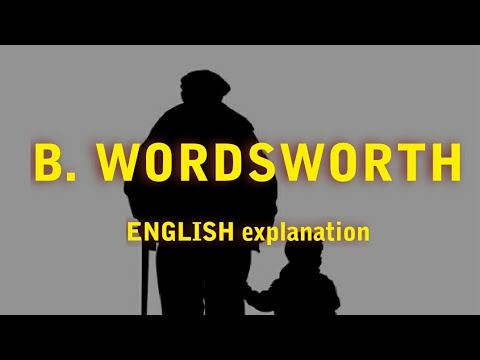Introduction
B. Wordsworth Summary And Themes By V. S. Naipaul B. Wordsworth is a short story by the acclaimed Trinidadian-British writer V. S. Naipaul, first published in 1960. The story reflects Naipaul’s characteristic exploration of postcolonial themes, identity, alienation, and the human condition in the context of a newly independent world. Naipaul is known for his nuanced portrayal of characters caught between cultures, and B. Wordsworth is no exception, using its protagonist, a disillusioned poet, to delve into the complexities of self-deception, artistic aspiration, and the harsh realities of life.
The story takes place in the Caribbean, against the backdrop of a postcolonial society where economic struggles, social divisions, and the tension between tradition and modernity are deeply felt. The titular character, B. Wordsworth, is a man who once had aspirations of being a great poet but now lives a life of disappointment, wandering aimlessly with a false sense of pride in his perceived artistry. His encounter with the narrator, a young man who yearns to be a poet but has little understanding of what it truly means to be one, forms the central axis of the narrative.
Plot Summary of B. Wordsworth
The story is narrated by a young man who admires the figure of B. Wordsworth, a self-styled poet who wanders the streets of the unnamed Caribbean city. The narrator, who is also a poet or aspiring poet, first encounters Wordsworth as an older man whose physical appearance suggests a life of struggle and disillusionment. Wordsworth is presented as a man who had once been proud of his work, but whose current existence is filled with frustration and self-deception.
Wordsworth is a poet who has lost his sense of purpose. He lives in the shadow of his former ambitions, wandering the streets and passing time in bars and cafes, nursing his wounds from years of neglect and lack of recognition. He is consumed by a sense of failure, but paradoxically, he clings to the belief that his poetry is profound and that recognition will one day come. This false belief forms the foundation of his identity, and he consistently rejects any notion that he has failed or that his poetry has no value. Instead, he attributes his failure to the lack of understanding from others and the limitations of his environment.
The narrator, who initially looks up to Wordsworth and believes in his artistic genius, befriends him and listens to his stories. The young man is fascinated by the older poet’s persona, viewing him as someone who has attained a form of wisdom and insight into the world. However, as the narrative unfolds, the narrator’s admiration for Wordsworth gradually turns to disillusionment as he sees the poet’s life for what it truly is—one of delusion and self-deception.
Wordsworth’s life is characterized by his intense and unrelenting belief in his own artistic worth, despite the lack of any real achievements or recognition. He speaks of his work with pride, often reciting his poetry, but it becomes clear that his poetry is not widely known or appreciated. His writing, once full of promise, has devolved into a series of repetitive and empty expressions that reflect his own sense of futility.
Read more
In one pivotal scene, Wordsworth reads some of his poetry to the narrator. The poems are shallow, uninspired, and riddled with clichés. Yet, Wordsworth believes they are revolutionary and deeply meaningful. The narrator is unable to reconcile the image of the poet he had built in his mind with the reality of the man before him. He begins to question the nature of artistic ambition and the personal cost of pursuing an idealized identity.
The story ends with a moment of bitter realization for the narrator. In a moment of reflection, he acknowledges that the poetic ideal he had hoped to follow is ultimately unattainable, and that the life of an artist is fraught with personal and existential conflict. The encounter with B. Wordsworth, for all its initial allure, serves as a warning about the dangers of self-deception and the disillusionment that often accompanies the pursuit of artistic fame.

Themes in B. Wordsworth
1. The Illusion of Artistic Glory
One of the central themes in B. Wordsworth is the illusion of artistic glory. Wordsworth is a man who has devoted his life to the pursuit of poetry, yet his work is largely unknown and unappreciated. His belief in his own greatness, despite the lack of external validation, reflects a fundamental theme of the story: the gap between the artist’s internal sense of purpose and the external reality of the world’s indifference. Naipaul illustrates how the pursuit of artistic recognition can become an all-consuming obsession that blinds the artist to their own limitations and the harsh realities of their situation.
B. Wordsworth Summary And Themes By V. S. Naipaul Wordsworth’s delusion of grandeur and his inability to recognize the mediocrity of his work expose the dangers of self-deception in the life of an artist. The story suggests that the quest for fame and recognition can lead to a distorted view of reality, where the artist becomes trapped in their own self-image, unable to move forward or accept the truth.
2. Identity and Self-Deception
B. Wordsworth Summary And Themes By V. S. Naipaul Another key theme in B. Wordsworth is identity and the role of self-deception in shaping one’s sense of self. Wordsworth’s identity as a poet is built on a fragile foundation of self-belief, despite the fact that his poetry has never been recognized or valued by others. His rejection of external criticism and his unwavering belief in his own artistic worth point to a deeper psychological mechanism—self-deception—that allows him to maintain his sense of identity in the face of failure.
The narrator’s own journey throughout the story mirrors Wordsworth’s self-deception. Initially captivated by Wordsworth’s sense of purpose, the narrator eventually comes to see that the poet’s sense of identity is a fragile construct built on a foundation of illusion. In the end, the narrator reflects on the cost of such self-deception and the toll it takes on a person’s ability to engage with reality.
3. The Search for Meaning in a Postcolonial World
B. Wordsworth Summary And Themes By V. S. Naipaul B. Wordsworth is also a meditation on the search for meaning in a postcolonial world. The story is set in the Caribbean, a region grappling with the aftermath of colonialism and the search for identity in the wake of independence. Both Wordsworth and the narrator are struggling with the question of what it means to be an artist in a society that is still in the process of defining itself.
B. Wordsworth Summary And Themes By V. S. Naipaul Naipaul uses the figure of Wordsworth as a symbol of the postcolonial intellectual who is caught between two worlds—the legacy of colonialism and the desire to forge a new, independent identity. Wordsworth’s inability to achieve recognition or create meaningful art reflects the difficulty faced by many in the postcolonial world who are trapped between the past and the future.
Read more
4. The Nature of Artistic Pursuit
The nature of artistic pursuit itself is another central theme in the story. Naipaul explores the idea that the life of an artist is often filled with disillusionment, loneliness, and self-doubt. The pursuit of artistic greatness is shown to be fraught with contradictions.B. Wordsworth Summary And Themes By V. S. Naipaul
Wordsworth, despite his fervent belief in the value of his work, finds himself increasingly isolated and consumed by the failure to gain recognition. The story suggests that the pursuit of art can be a double-edged sword, offering moments of creative fulfillment but also leading to personal and existential crises.
Naipaul’s portrayal of the artist as a figure caught in an endless cycle of self-reinvention and disappointment is a sobering reflection on the challenges of the artistic life.B. Wordsworth Summary And Themes By V. S. Naipaul
5. Generational Conflict and Mentorship
There is a subtle theme of generational conflict in B. Wordsworth, as the narrator, a younger man, looks up to Wordsworth and seeks guidance from him. However, as the story progresses, the mentor-student relationship unravels as the narrator begins to see the flaws and contradictions in Wordsworth’s character.
This conflict reflects the broader tension between older and younger generations, particularly in the context of postcolonial societies where the younger generation is seeking to establish its own identity and break away from the legacy of the past.B. Wordsworth Summary And Themes By V. S. Naipaul
:max_bytes(150000):strip_icc()/wordsworthengraving-56a73fb03df78cf77293aacb.jpg)
Conclusion
B. Wordsworth Summary And Themes By V. S. Naipaul B. Wordsworth is a powerful exploration of the disillusionment and self-deception that often accompany the pursuit of artistic greatness. Through the character of B. Wordsworth, Naipaul examines the nature of identity, ambition, and the quest for meaning in a postcolonial world.
The story serves as both a critique of romanticized notions of the artist and a reflection on the personal cost of artistic pursuit. Naipaul’s nuanced portrayal of the relationship between the narrator and Wordsworth provides a rich, multifaceted narrative that raises important questions about the nature of art, failure, and the human desire for recognition.B. Wordsworth Summary And Themes By V. S. Naipaul
Read more
(FAQ)
1. What is the significance of the name B. Wordsworth?
The name “B. Wordsworth” is a literary allusion to the famous English poet William Wordsworth, who is associated with Romanticism and the exploration of nature, emotion, and the individual’s connection to the world. By naming the character “B. Wordsworth,” Naipaul draws a contrast between the lofty ideals of poetry associated with the original Wordsworth and the disillusioned, failed poet who now bears his name. The name serves as an ironic commentary on the gap between the idealized figure of the poet and the reality of a life spent in obscurity.
2. How does the story critique the idea of the “romantic” poet?
The story critiques the idea of the “romantic” poet by highlighting the delusion that often accompanies the pursuit of art. Wordsworth’s belief in his own greatness, despite his lack of success or recognition, embodies the romantic notion of the artist as someone who creates for the sake of the art itself, rather than for external validation. However, Naipaul suggests that this idealized view of the artist is often a form of self-deception, which can lead to a life of failure and frustration.
3. What is the role of the narrator in B. Wordsworth?
The narrator serves as both a participant in the story and an observer of Wordsworth’s life. His initial admiration for the poet reflects the romanticized view of the artist, while his eventual disillusionment highlights the theme of self-deception. The narrator’s transformation from an eager admirer to a more cynical observer represents the broader theme of the cost of pursuing an idealized version of identity.
4. What does Naipaul suggest about the nature of artistic ambition?
Naipaul suggests that artistic ambition is fraught with contradictions. While it can be a source of personal fulfillment and creative expression, it can also lead to disillusionment and self-deception. The pursuit of artistic greatness is shown to be an isolating and often painful experience, where the artist is forced to confront the gap between their ideals and the reality of their work.
5. How does B. Wordsworth reflect Naipaul’s broader themes?
B. Wordsworth reflects Naipaul’s broader themes of identity, alienation, and the struggle to find meaning in a postcolonial world. The story’s portrayal of Wordsworth’s failed artistic ambitions mirrors Naipaul’s exploration of the difficulties faced by individuals living in a postcolonial society, as they try to reconcile their personal aspirations with the realities of their environment.
Read more

















